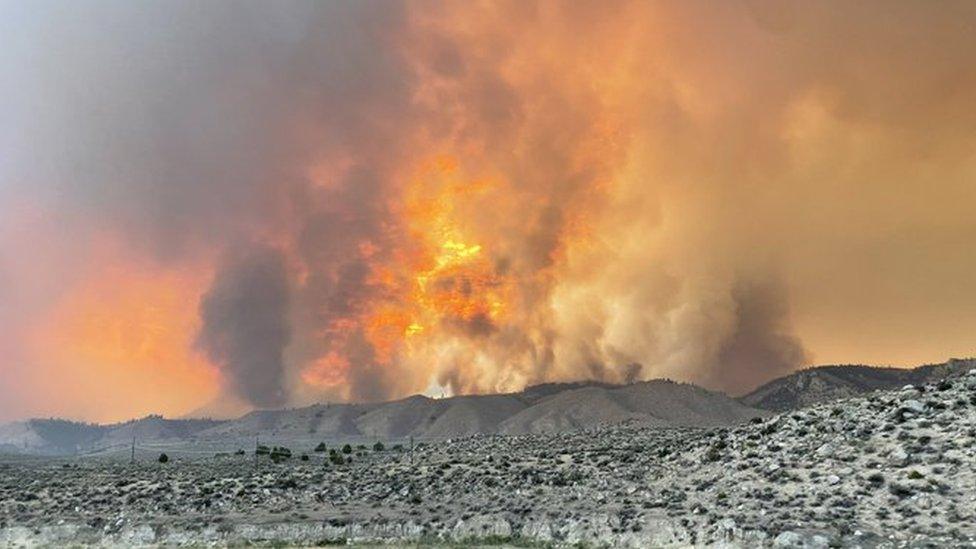US heatwave: Wildfires rage in western states as temperatures soar
- Published

Firefighters are struggling to contain California's Beckwourth Complex fires
Wildfires are raging in the west of the United States as the region is hit by a heatwave that has brought record temperatures to several areas.
Communities have been told to evacuate as firefighters struggle to battle the blazes in the extreme conditions.
In California, residents were urged to cut power consumption after interstate power lines were knocked out.
On Saturday, two firefighters in Arizona died when their aircraft crashed while responding to a blaze.
Meanwhile, Las Vegas, Nevada, matched its all-time temperature high of 47.2C (117F) on Saturday.
Firefighters battling the many wildfires in the region say the air is so dry that much of the water dropped by aircraft to quell the flames evaporates before it reaches the ground.
It comes just weeks after another dangerous heatwave hit North America, in which hundreds of sudden deaths were recorded, many of them suspected of being heat-related.
The region experienced its hottest June on record, according to the EU's Earth observation programme.
Experts say that climate change is expected to increase the frequency of extreme weather events, such as heatwaves. But linking any single event to global warming is complicated.
However, a study by climate researchers said the heat that scorched western Canada and the US at the end of June was "virtually impossible" without climate change.
Dangerous heat continues across North America
Arizona's Bureau of Land Management paid tribute to the two "brave wildland firefighters" who died in a plane crash while performing aerial reconnaissance, command and control over the lightning-caused Cedar Basin Fire.
"Our hearts are heavy tonight with sincere condolences to families, loved ones and firefighters affected by this tragic aviation accident", the agency said.
The accident occurred at around noon local time (19:00 GMT) on Saturday near the small community of Wikieup. Further information was not immediately available and the firefighters have not been officially named.
In the north of Nevada, near the border with California, people were evacuated from their homes as wildfires triggered by lightning strikes tore through parts of the Sierra Nevada forest region.
One fire, which more than doubled in size between Friday and Saturday, sent up a giant cloud of smoke and ash which, combined with the dry heat, generated its own lightning, according to the Los Angeles Times.
Allow Instagram content?
This article contains content provided by Instagram. We ask for your permission before anything is loaded, as they may be using cookies and other technologies. You may want to read Meta’s Instagram cookie policy, external and privacy policy, external before accepting. To view this content choose ‘accept and continue’.

"As long as it's this hot and we have these low humidities, it's kind of hard to tell when and where we're going to catch this," Lisa Cox, information officer for the so-called Beckwourth Complex fires, told the newspaper.
In Oregon, a wildfire fanned by strong winds in the Fremont-Winema National Forest doubled in size to 120 sq miles (311 sq km) on Saturday.
The fire damaged power cables that send electricity to California. Power grid operators in California urged customers to conserve electricity by reducing their use of appliances and to keep thermostats higher during the evening when solar energy is diminished or no longer available.
In Idaho, Governor Brad Little last week declared a wildfire emergency and mobilised the state's National Guard to help fight fires also sparked by lightning.
Fires have also been burning in Canada's western province of British Columbia amid unusually hot, dry weather. An entire village was wiped out in a blaze earlier this month after it recorded Canada's highest ever temperature of 49.6C (121.3F).
The country on Sunday ordered new railway safety rules for areas where there is a high wildfire risk. The rules will require Canadian National Railway and Canadian Pacific Railway to take a number of precautions, including reducing train speeds when there is an extreme fire risk and removing combustible material near tracks.
Millions warned about heat
Several areas in Nevada and California have matched or passed temperature records, according to preliminary data by the National Weather Service (NWS), and the extreme heat is expected to continue.
A temperature of 54.4C (130F) was registered in California's Death Valley on Friday, matching one recorded in August 2020 - which some argue is the highest temperature ever reliably recorded on Earth. A temperature of 56.7C (134F) was registered in the area in 1913, but this is contested by climate experts.
Millions of people are under an excessive heat warning, with those affected urged to drink plenty of water and stay in air-conditioned buildings where possible.
Cooling centres - air-conditioned public spaces - have been set up in some areas to help residents get relief from the heatwave.

A cooling centre was set up at the Oregon Convention Center in Portland to help people affected by the heatwave
Heat warnings have also been issued in parts of Canada, with those affected urged to consider rescheduling outdoor activities for cooler periods of the day, and monitor for symptoms of heat stroke or heat exhaustion.
- Attribution
- Published10 July 2021

- Published19 August 2020

